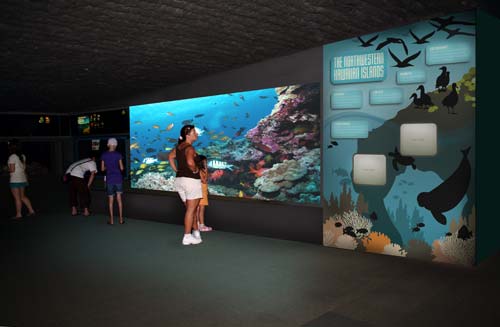Aquarium to host life from northwestern isles

An aquarium exhibit featuring species from the Northwestern Hawaiian Islands will open next spring at the Waikiki Aquarium. Among the new species will be table corals, masked angelfish, yellow barbel goatfish and the Japanese pygmy angelfish.
A new exhibit at Waikiki Aquarium set to open in spring 2011 will take visitors somewhere most have never been — the Northwestern Hawaiian Islands.
Construction for the aquarium’s latest project — the Northwestern Hawaiian Islands Public Display — is under way. When finished, it will feature organisms from the isolated islands.
"Many of the species that will be on display are abundant around the Northwestern Hawaiian Islands, but are extremely rare or absent around the main Hawaiian Islands," said aquarium director Andrew Rossiter.
He plans to introduce about 20 new species of fish and about 10 new species of coral to the 4,000-gallon tank.
Among the new species that will find a home in the ecosystem are table corals, masked angelfish, yellow barbel goatfish and the Japanese pygmy angelfish.
Rossiter said he hopes to bring the Northwestern Hawaiian Islands to people because "many people cannot get to the islands."
Don't miss out on what's happening!
Stay in touch with breaking news, as it happens, conveniently in your email inbox. It's FREE!
The Northwestern Hawaiian Islands are approximately 1,000 miles northwest of Niihau and Kauai and feature more than 7,000 life forms — a fourth of which are exclusive to the Islands.
"For many people, this will be the only opportunity to see them," Rossiter said. He also said the new exhibit will give attention to the isolated islands and manifest their uniqueness.
The Northwestern Hawaiian Islands display will be located on the right wall of Gallery 4 and will feature interactive touchscreen monitors with information on the region’s ecology and biodiversity.
The new exhibit will take the place of three former exhibits — the Hawaiian pawn shrimps, the Hawaiian fish pond and the Hawaiian fisheries. The animals from those galleries have been redistributed to other tanks, Rossiter said.
The aquarium is working with the Office of National Marine Sanctuaries and Papahanaumokuakea Marine National Monument to complete the $300,000 permanent exhibit. Funding will be covered by proceeds from the past three annual summer concert series and by the National Oceanic and Atmospheric Administration.




